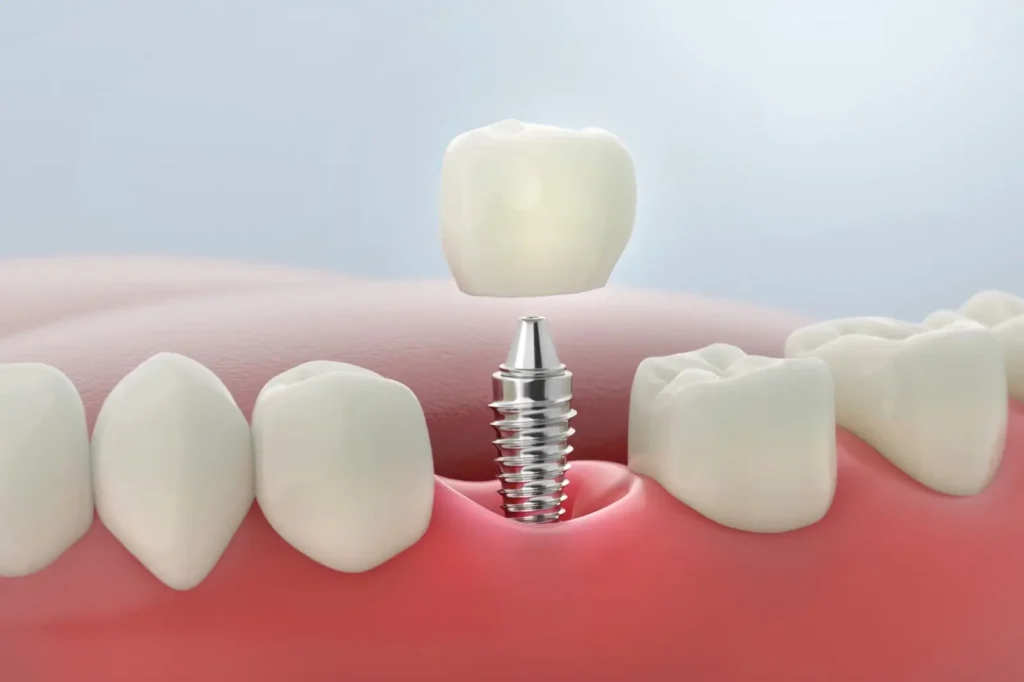Dental implants have revolutionized tooth replacement by offering a permanent, stable, and natural-looking solution for missing teeth. This comprehensive guide explores every aspect of dental implants—from types, procedures, and care to potential risks and cost considerations.

What Are Tooth Replacement?
Dental implants are artificial tooth roots made of titanium that are surgically inserted into the jawbone. Once healed, a crown is placed on top, mimicking the look and function of a natural tooth.
Why Titanium?
Titanium is biocompatible, meaning it fuses well with the bone through a process called osseointegration. It is also durable and resistant to corrosion.
Who Is a Good Candidate for Tooth Replacement ?
Not everyone with missing teeth is eligible for implants. A dentist will evaluate several factors read more.
Key Eligibility Factors
- Sufficient jawbone density
- Healthy gums (no active periodontal disease)
- Non-smokers or those willing to quit
- Good general health
- Commitment to oral hygiene
Types of Tooth Replacement
There are several types depending on placement, number of teeth missing, and jawbone condition.
Endosteal Implants (Most Common)
- Placed directly into the jawbone
- Typically used in patients with healthy bone
- Can hold one or more crowns
Subperiosteal Implants
- Placed under the gum but on top of the bone
- Ideal for patients with insufficient jawbone
- Less invasive but less stable long-term
Zygomatic Implants
- Used in severe bone loss cases
- Anchored in the cheekbone (zygoma)
- Require experienced specialists
Step-by-Step Implant Procedure
1. Initial Consultation
A comprehensive dental exam, X-rays, and sometimes 3D imaging are done to plan the procedure.
2. Tooth Extraction (if needed)
If the damaged tooth is still in place, it will be gently extracted.
3. Bone Grafting (if needed)
If the jawbone is too soft or thin, bone grafting may be required before implant placement.
4. Implant Placement
The titanium post is surgically inserted into the jawbone and left to heal over 3–6 months.
5. Abutment Placement
Once healing is complete, a small connector (abutment) is attached to the implant.
6. Crown Placement
A custom-made dental crown is mounted onto the abutment, completing the restoration.
Healing and Recovery
Healing time depends on the individual’s health, bone quality, and whether bone grafting was needed.
HTypical Timeline
- First 24 hours: Minor bleeding and swelling
- 1 week: Stitches removed or dissolved
- 3–6 months: Bone integrates with implant
- After 6 months: Crown is placed
Tips for Faster Recovery
- Avoid smoking and alcohol
- Eat soft foods
- Maintain good oral hygiene
- Follow prescribed medication and appointments
Benefits of Dental Implants
Functional Benefits
- Strong chewing power
- Improved speech
- Prevents bone loss and jaw shrinkage
Aesthetic Benefits
- Natural look and feel
- Preserves facial structure
- No visible metal or hooks like dentures
Emotional and Social Impact
- Restores confidence
- Eliminates worry about slipping dentures
- Improves quality of life
Risks and Complications
Although implants have a high success rate (~95%), risks include:
Short-Term Risks
- Infection at the implant site
- Nerve damage
- Sinus problems (for upper jaw implants)
Long-Term Issues
- Implant failure due to poor integration
- Bone loss
- Gum disease around the implant (peri-implantitis)
Implant Maintenance and Longevity
With proper care, implants can last 20+ years or even a lifetime.
Daily Care Tips
- Brush twice daily
- Floss with implant-safe floss or water flosser
- Use antibacterial mouthwash
Dental Visits
- Get cleanings every 6 months
- X-rays every 12–24 months
- Early detection of complications saves the implant
Cost of Dental Implants
Prices vary based on country, clinic, and procedure complexity.
Average Costs (USD)
- Single implant: $3,000–$6,000
- All-on-4 implants: $15,000–$30,000 per jaw
- Bone grafting (if needed): $500–$3,000
Does Insurance Cover Implants?
Most dental insurance plans do not fully cover implants. However, partial reimbursement for parts like extractions or crowns is possible.
Alternatives to Dental Implants
Dentures
- Removable
- Affordable but less stable
- May cause bone loss over time
Dental Bridges
- Fixed
- Require filing down adjacent teeth
- Less expensive than implants but may not last as long
Dental Implants in Different Age Groups
Young Adults
- Jaw must be fully developed (~18+ years)
- Implants preserve aesthetics and function long-term
Older Adults
- Age is not a limitation
- Bone density is more critical than age
- Many 70–80-year-olds get successful implants
Latest Advances in Implant Dentistry
3D Printing and Guided Surgery
Improves accuracy, reduces surgical time, and enhances results.
Same-Day Implants
Implant and crown placement on the same day. Not for all cases but growing in popularity.
Mini Implants
Smaller diameter implants for tight spaces or less bone. Less invasive and faster healing.
Emotional Journey of Tooth Loss and Recovery
Losing teeth can affect mental health, self-image, and relationships. Implants restore more than teeth—they rebuild identity and confidence.
Real-Life Testimonials
“Getting implants changed how I eat, speak, and smile. I feel like myself again.” – Sarah M., 54
“I was terrified of dentures. Implants gave me my youth back.” – Omar H., 67
Trusted External Source
For more scientific details, check the American Academy of Implant Dentistry:
aaid-implant.org
